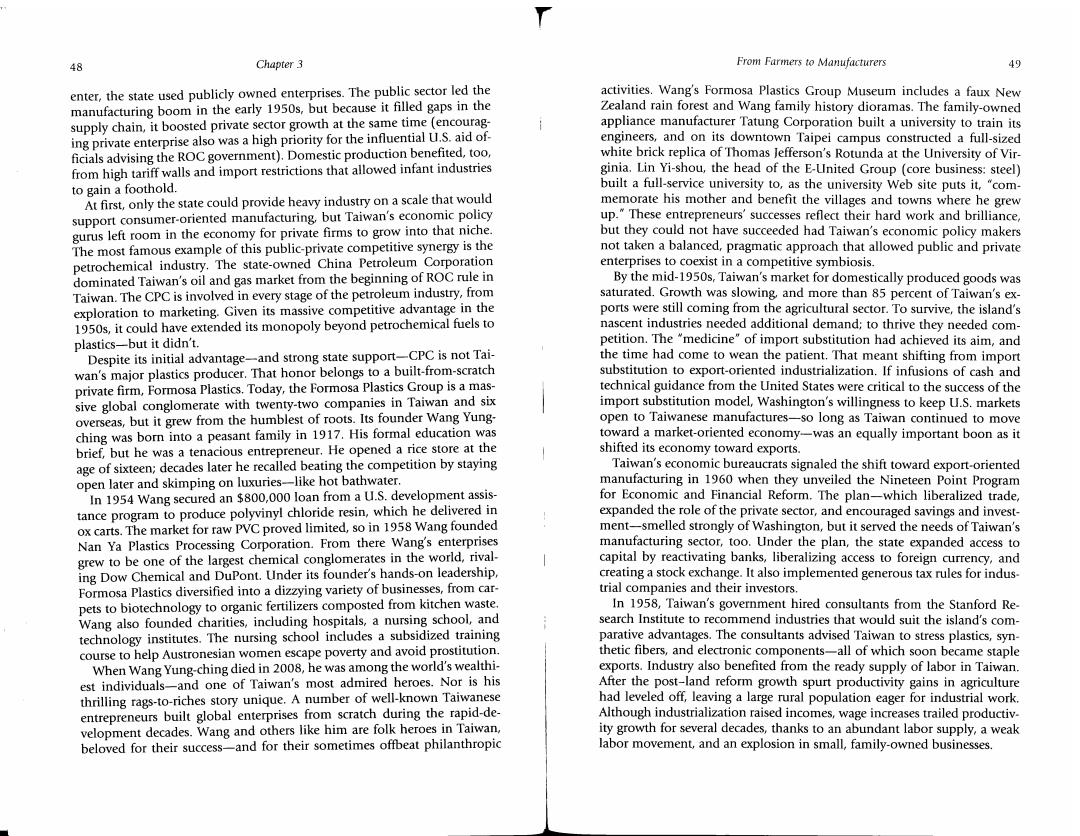正在加载图片...

48 Chapter 3 From Farmers to Manufacturers 49 enter,the state used publicly owned enterprises.The public sector led the activities.Wang's Formosa Plastics Group Museum includes a faux New manufacturing boom in the early 1950s,but because it filled gaps in the Zealand rain forest and Wang family history dioramas.The family-owned supply chain,it boosted private sector growth at the same time (encourag- appliance manufacturer Tatung Corporation built a university to train its ing private enterprise also was a high priority for the influential U.S.aid of- engineers,and on its downtown Taipei campus constructed a full-sized ficials advising the ROC government).Domestic production benefited,too, white brick replica of Thomas lefferson's Rotunda at the University of Vir- from high tariff walls and import restrictions that allowed infant industries ginia.Lin Yi-shou,the head of the E-United Group (core business:steel) to gain a foothold. built a full-service university to,as the university Web site puts it,"com- At first,only the state could provide heavy industry on a scale that would memorate his mother and benefit the villages and towns where he grew support consumer-oriented manufacturing,but Taiwan's economic policy up."These entrepreneurs'successes reflect their hard work and brilliance, gurus left room in the economy for private firms to grow into that niche. but they could not have succeeded had Taiwan's economic policy makers The most famous example of this public-private competitive synergy is the not taken a balanced,pragmatic approach that allowed public and private petrochemical industry.The state-owned China Petroleum Corporation enterprises to coexist in a competitive symbiosis. dominated Taiwan's oil and gas market from the beginning of ROC rule in By the mid-1950s,Taiwan's market for domestically produced goods was Taiwan.The CPC is involved in every stage of the petroleum industry,from saturated.Growth was slowing,and more than 85 percent of Taiwan's ex- exploration to marketing.Given its massive competitive advantage in the ports were still coming from the agricultural sector.To survive,the island's 1950s,it could have extended its monopoly beyond petrochemical fuels to nascent industries needed additional demand;to thrive they needed com- plastics-but it didn't. petition.The "medicine"of import substitution had achieved its aim,and Despite its initial advantage-and strong state support-CPC is not Tai- the time had come to wean the patient.That meant shifting from import wan's major plastics producer.That honor belongs to a built-from-scratch substitution to export-oriented industrialization.If infusions of cash and private firm,Formosa Plastics.Today,the Formosa Plastics Group is a mas- technical guidance from the United States were critical to the success of the sive global conglomerate with twenty-two companies in Taiwan and six import substitution model,Washington's willingness to keep U.S.markets overseas,but it grew from the humblest of roots.Its founder Wang Yung- open to Taiwanese manufactures-so long as Taiwan continued to move ching was born into a peasant family in 1917.His formal education was toward a market-oriented economy-was an equally important boon as it brief,but he was a tenacious entrepreneur.He opened a rice store at the shifted its economy toward exports. age of sixteen;decades later he recalled beating the competition by staying Taiwan's economic bureaucrats signaled the shift toward export-oriented open later and skimping on luxuries-like hot bathwater. manufacturing in 1960 when they unveiled the Nineteen Point Program In 1954 Wang secured an $800,000 loan from a U.S.development assis- for Economic and Financial Reform.The plan-which liberalized trade, tance program to produce polyvinyl chloride resin,which he delivered in expanded the role of the private sector,and encouraged savings and invest- ox carts.The market for raw PVC proved limited,so in 1958 Wang founded ment-smelled strongly of Washington,but it served the needs of Taiwan's Nan Ya Plastics Processing Corporation.From there Wang's enterprises manufacturing sector,too.Under the plan,the state expanded access to grew to be one of the largest chemical conglomerates in the world,rival- capital by reactivating banks,liberalizing access to foreign currency,and ing Dow Chemical and DuPont.Under its founder's hands-on leadership, creating a stock exchange.It also implemented generous tax rules for indus- Formosa Plastics diversified into a dizzying variety of businesses,from car- trial companies and their investors. pets to biotechnology to organic fertilizers composted from kitchen waste. In 1958,Taiwan's government hired consultants from the Stanford Re- Wang also founded charities,including hospitals,a nursing school,and search Institute to recommend industries that would suit the island's com- technology institutes.The nursing school includes a subsidized training parative advantages.The consultants advised Taiwan to stress plastics,syn- course to help Austronesian women escape poverty and avoid prostitution. thetic fibers,and electronic components-all of which soon became staple When Wang Yung-ching died in 2008,he was among the world's wealthi- exports.Industry also benefited from the ready supply of labor in Taiwan. est individuals-and one of Taiwan's most admired heroes.Nor is his After the post-land reform growth spurt productivity gains in agriculture thrilling rags-to-riches story unique.A number of well-known Taiwanese had leveled off,leaving a large rural population eager for industrial work. entrepreneurs built global enterprises from scratch during the rapid-de- Although industrialization raised incomes,wage increases trailed productiv- velopment decades.Wang and others like him are folk heroes in Taiwan, ity growth for several decades,thanks to an abundant labor supply,a weak beloved for their success-and for their sometimes offbeat philanthropic labor movement,and an explosion in small,family-owned businesses